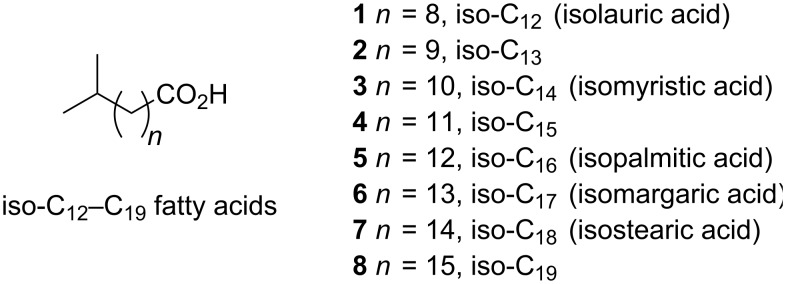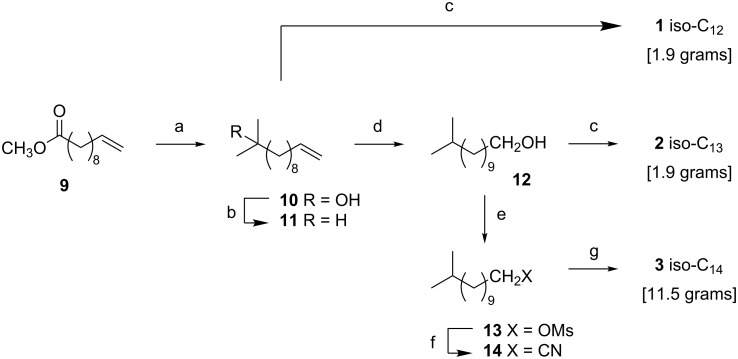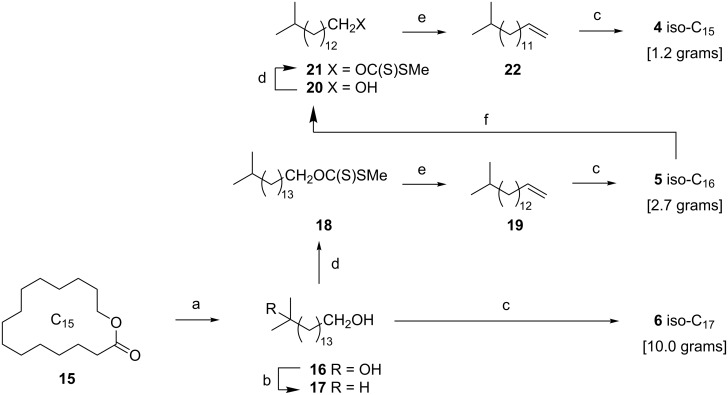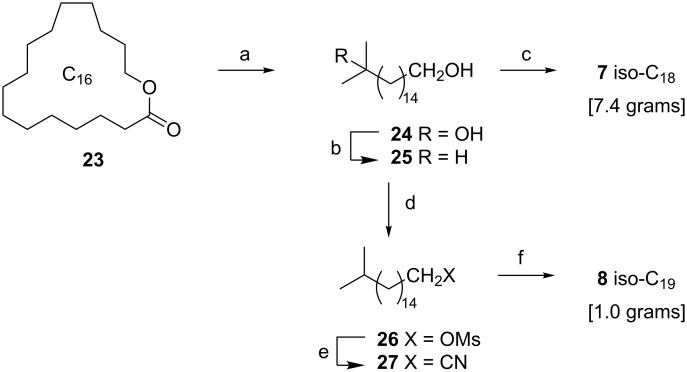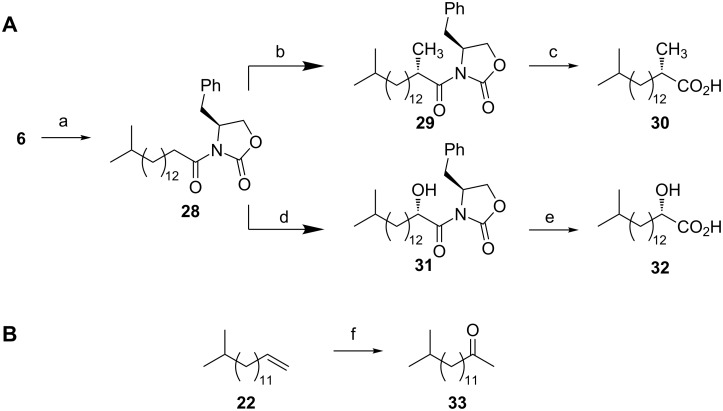Abstract
A gram-scale synthesis of terminally-branched iso-fatty acids (iso-C12–C19) was developed commencing with methyl undec-10-enoate (methyl undecylenate) (for iso-C12–C14) or the C15 and C16 lactones pentadecanolide (for iso-C15–C17) and hexadecanolide (for iso-C18–C19). Central to the approaches outlined is the two-step construction of the terminal isopropyl group through addition of methylmagnesium bromide to the ester/lactones and selective reduction of the resulting tertiary alcohols. Thus, the C12, C17 and C18 iso-fatty acids were obtained in three steps from commercially-available starting materials, and the remaining C13–C16 and C19 iso-fatty acids were prepared by homologation or recursive dehomologations of these fatty acids or through intercepting appropriate intermediates. Highlighting the synthetic potential of the iso-fatty acids and various intermediates prepared herein, we describe the synthesis of the natural products (S)-2,15-dimethylpalmitic acid, (S)-2-hydroxy-15-methylpalmitic acid, and 2-oxo-14-methylpentadecane.
Keywords: chemoselective reduction, Evans’ auxiliary, Grignard addition, homologation, ionic hydrogenation
Introduction
Long-chain iso-fatty acids occur in a broad range of organisms, and are especially abundant in bacteria where, through incorporation into phospholipids, they influence membrane fluidity [1]. Emerging evidence has revealed unexpected roles for certain iso-fatty acids; for example iso-C15 and iso-C17 fatty acids have been shown to be essential in the development of the model eukaryote Caenorhabditis elegans [2]. They are present as esters and amides in natural products including septacidin [3], teicoplanins [4], tunicaminyluracil-based antibiotics [5] (tunicamycins [6], corynetoxins [7], and streptovirudins [8]), the arylomycin glycopeptide antibiotics [9–10], maradolipids [11], plipastatin-type lipopeptides [12], Nod factors [13], glycosylglycerides [14–15], phosphoglycolipids [16], and various sphingolipids [17–19]. The terminal isopropyl group of the iso-fatty acids arises from valine and leucine, which through transamination and decarboxylation reactions yield isobutyryl-CoA and isovaleryl-CoA [20]. These starter units are elongated by fatty acid synthases to the final iso-fatty acids (even numbered for isobutyryl-CoA; odd-numbered for isovaleryl-CoA) through extension with malonyl-CoA [21–22]. Long-chain iso-fatty acids are important analytical reference compounds owing to the presence of these materials in tobacco [23], wool wax [24], butter fat [25], human sebaceous secretions [26] (adult skin [27], meibum [28], cerumen [29], and newborn vernix caseosa [30–31]), and a wide variety of microbiological samples [1].
Previous syntheses of iso-fatty acids have typically utilized extended, multi-step sequences. Two main approaches have been used: (1) two-component cross-couplings that include α-ketoester alkylation/decarboxylation [32–33], aldehyde–olefin photoaddition [34], acetylide alkylation (sp3–sp) [35–36], Wittig coupling [3,21,37–39], Kolbe electrosynthesis [35,40–42], organocadmium (sp2–sp3) [43–46], organomagnesium (sp2–sp3) [47], or organocopper (sp3–sp3) [48–49] cross-couplings; or (2) bidirectional extension of a central thiophene C4-fragment [50]. Two fundamentally different approaches worth special mention are the synthesis of the iso-C14 acid 3 by direct hydro-isopropylation of the terminal alkene of methyl undecylenate (available as a pyrolysis product of ricinoleic acid) using isopropyl chloroformate and ethyldichloroaluminium [51], and the synthesis of the iso-C17 acid 6 from methyl ustilate (15,16-dihydroxypalmitate) [52]. Despite the interest in natural products containing iso-fatty acids, these compounds are not readily acquired in multigram quantities due to the complexity of the synthetic routes or limited availability of starting materials. To overcome these problems, we report the scalable, gram-scale syntheses of eight common iso-C12–C19 acids 1–8 (Figure 1), from readily available starting materials. To illustrate the opportunities that our approach provides, we demonstrate the elaboration of the C17-iso-fatty acid 6 and an intermediate, 22, to several terminal-branched natural products that have not previously been synthesized.
Figure 1.
Structures of iso-fatty acids.
Results and Discussion
Our approach to the iso-C12–C14 fatty acids 1–3 commenced from methyl undec-10-enoate (methyl undecylenate) 9. Reaction of 9 with methylmagnesium bromide afforded the tertiary alcohol 10 in 98% yield (Scheme 1). Selective reduction of the tertiary alcohol of 10 was achieved by ‘ionic hydrogenation’ with triethylsilane and BF3·Et2O [53], affording 11. Oxidative cleavage of 11 with KMnO4/Bu4NBr [54] afforded iso-C12 acid 1. Alternatively, anti-Markovnikov hydration of 11, using I2/NaBH4 then hydrogen peroxide [55], afforded the alcohol 12, and oxidation of 12 with KMnO4/Bu4NBr afforded iso-C13 acid 2. Alternatively, alcohol 12 could be intercepted and converted to the mesylate 13 using MsCl/Et3N [56] and thence the nitrile 14 (KCN in DMSO/THF). Finally, hydrolysis of the nitrile 14 with NaOH in H2O/EtOH afforded iso-C14 acid 3.
Scheme 1.
Synthesis of iso-C12 1, iso-C13 2, and iso-C14 3 fatty acids from methyl undecylenate (9). Reagents and conditions: (a) MeMgBr, THF, 98%; (b) BF3·Et2O, Et3SiH, CH2Cl2, 99%; (c) KMnO4, Bu4NBr, AcOH, H2O, 88% for 1, 96% for 2; (d) i) I2, NaBH4, THF, ii) H2O2, 95%; (e) MsCl, Et3N, CH2Cl2, 98%; (f) KCN, DMSO, THF, 72%; (g) aq NaOH, EtOH, 96%.
The iso-C15–C17 fatty acids 4–6 were prepared from the readily available C15 lactone pentadecanolide (exaltolide, 15) [57], a natural product that is produced industrially for use as a musk-odored perfumery fixative. Reaction of 15 with methylmagnesium bromide afforded the tertiary alcohol 16 in 98% yield (Scheme 2). Selective reduction of the tertiary alcohol of 16 was achieved using triethylsilane/BF3·Et2O [53], yielding 17. Finally, oxidation of 17 with KMnO4/Bu4NBr [54] afforded the iso-C17 acid 6. The iso-C15 acid 4 and iso-C16 acid 5 were prepared by recursive dehomologation through intercepting the alcohol 17. Preparation of the xanthate ester 18 (NaH, CS2, then MeI) [58] followed by Chugaev elimination afforded the terminal alkene 19. Oxidative cleavage of 19 using KMnO4/Bu4NBr [54] afforded iso-C16 acid 5. Reduction of 5 (BH3·Me2S) [59] afforded the alcohol 20 that when subjected to the same transformations as before, via the xanthate ester 21, delivered the terminal alkene 22. Finally, oxidative cleavage (KMnO4/Bu4NBr) [54] of 22 afforded iso-C15 acid 4.
Scheme 2.
Synthesis of iso-C15 4, iso-C16 5, and iso-C17 6 fatty acids from pentadecanolide (15). Reagents and conditions: (a) MeMgBr, THF, 98%; (b) BF3·Et2O, Et3SiH, CH2Cl2, 96%; (c) KMnO4, Bu4NBr, AcOH, H2O, 95% for 6, 93% for 5; 86% for 4; (d) NaH, CS2 then MeI; (e) reflux, 89% for 19 over 2 steps from 17, 98% for 22 over 2 steps from 20; (f) BH3·SMe2, THF, 78%.
The iso-C18 7 and iso-C19 8 fatty acids were synthesized through similar approaches from the related C16 lactone hexadecanolide 23 [60] (Scheme 3). Reaction of 23 with methylmagnesium bromide afforded 24; triethylsilane/BF3·Et2O [53] reduction gave 25; and KMnO4/Bu4NBr oxidation afforded iso-C18 acid 7 (Scheme 3). The iso-C19 acid 8 was readily prepared by a three-step homologation through intercepting the alcohol 25. Thus, mesylation of 25 (MsCl/Et3N [56]) afforded 26; substitution (KCN/DMSO) afforded the nitrile 27; and hydrolysis (NaOH in H2O/EtOH) of 27 afforded 8.
Scheme 3.
Synthesis of iso-C18 7 and iso-C19 8 fatty acids from hexadecanolide 23. Reagents and conditions: (a) MeMgBr, THF, 97%; (b) BF3·Et2O, Et3SiH, CH2Cl2, 95%; (c) KMnO4, Bu4NBr, AcOH, H2O, 82%; (d) MsCl, Et3N, 96%; (e) KCN, DMSO, THF, 75%; (f) aq NaOH, EtOH, 86%.
The above routes enable the acquisition of (multi)gram quantities of the iso-C12–19 acids 1–8, and provide opportunities for their use as starting materials for the preparation of more complex fatty acids. To illustrate their potential we undertook the synthesis of several representative natural products (Scheme 4). 2,15-Dimethylpalmitic acid has been isolated from a microaerophilic subsurface microbial community [61], and is a component of human newborn vernix caseosa [31], although the absolute configuration of natural samples has not been determined. Conversion of iso-C17 acid 6 to the N-acyloxazolidinone 28 was achieved using pivalyl chloride/LiCl [62] and (S)-4-benzyloxazolidinone. Diastereoselective methylation [63] of the chelated Z-enolate, derived from deprotonation of 28, using NaHMDS, followed by addition of iodomethane, yielded 29 as a single diastereoisomer (as determined by 1H NMR) in 80% yield. Cleavage of the chiral auxiliary using LiOH/H2O2 (which occurs without racemization at the α-position) [64] afforded (S)-2,15-dimethylpalmitic acid (30) in 98% yield. 2-Hydroxy-15-methylpalmitic acid has been identified from a range of sources [1] including the myxobacterium Stigmatella aurantiaca [21,65], and the oral bacterium Veillonella parvula [66], although the absolute configuration has not been reported. Diastereoselective hydroxylation [67] of the chelated Z-enolate derived from 28 using the Davis oxaziridine [68] afforded the 2-hydroxy compound 31 as a single diastereoisomer (as determined by 1H NMR) in 71% yield. Esterification with MeOMgCl [69] (which has been shown not to cause epimerization at the α-position [67]) and saponification [70] afforded (S)-2-hydroxy-15-methylpalmitic acid (32). The ketone 33 was isolated from Xanthomonas campestris pv. vesicatoria 85-10 [71]. A direct one step synthesis of 33 was achieved in 51% yield by Wacker oxidation using Pd/O2 [72] of the alkene 22, intercepted from the synthesis of the iso-C15 acid 4.
Scheme 4.
Synthesis of (A) 2-methyl- and 2-hydroxy-iso-fatty acids 30 and 32, and (B) the ketone 33. Reagents and conditions: (a) Et3N, PivCl, LiCl, DMAP, (S)-4-benzyloxazolidinone, 71%; (b) NaHMDS, MeI, THF, 80%; (c) LiOH, H2O2, THF, H2O, 98%; (d) NaHMDS, Davis oxaziridine, THF, 71%; (e) i) iPrMgCl, MeOH, 76%, ii) NaOH, MeOH, 83%; (f) O2, PdCl2, DMA, H2O, 51%.
Conclusion
We have accomplished a highly practical synthesis of the homologous iso-fatty acids 1–8. The iso-C12 1, iso-C17 6 and iso-C18 7 acids were prepared from commercially-available starting materials through three-step sequences and produced more than 1 g of each of the three iso-fatty acids in just 2 days each. The remaining five fatty acids were each prepared on >1 g scale by homologation or dehomologation reactions, or through the elaboration of intermediates in the synthesis of 1. Underscoring the practicability of this approach, the iso-fatty acids or appropriate intermediates were used for the preparation of three natural products, enantiopure acids 30 and 32, and the ketone 33. The simplicity of our approach suggests that it will be of great utility in the preparation of iso-fatty acids for incorporation into more complex molecules.
Supporting Information
Experimental part.
NMR spectra.
Acknowledgments
The authors thank the Australian Research Council for financial support.
References
- 1.Kaneda T. Microbiol Rev. 1991;55:288–302. doi: 10.1128/mr.55.2.288-302.1991. [DOI] [PMC free article] [PubMed] [Google Scholar]
- 2.Kniazeva M, Crawford Q T, Seiber M, Wang C Y, Han M. PLoS Biol. 2004;2:E257. doi: 10.1371/journal.pbio.0020257. [DOI] [PMC free article] [PubMed] [Google Scholar]
- 3.Acton E M, Ryan K J, Luetzow A E. J Med Chem. 1977;20:1362–1371. doi: 10.1021/jm00221a002. [DOI] [PubMed] [Google Scholar]
- 4.Borghi A, Antonini P, Zanol M, Ferrari P, Zerilli L F, Lancini G C. J Antibiot. 1989;42:361–366. doi: 10.7164/antibiotics.42.361. [DOI] [PubMed] [Google Scholar]
- 5.Cockrum P A, Edgar J A. J Chromatogr. 1983;268:245–254. doi: 10.1016/S0021-9673(01)95411-1. [DOI] [Google Scholar]
- 6.Ito T, Takatsuki A, Kawamura K, Sato K, Tamura G. Agric Biol Chem. 1980;44:695–698. doi: 10.1271/bbb1961.44.695. [DOI] [Google Scholar]
- 7.Edgar J A, Frahn J L, Cockrum P A, Anderton N, Jago M V, Culvenor C C J, Jones A J, Murray K, Shaw K J. J Chem Soc, Chem Commun. 1982:222–224. doi: 10.1039/C39820000222. [DOI] [Google Scholar]
- 8.Eckardt K, Wetzstein H, Thrum H, Ihn W. J Antibiot. 1980;33:908–910. doi: 10.7164/antibiotics.33.908. [DOI] [PubMed] [Google Scholar]
- 9.Kulanthaivel P, Kreuzman A J, Strege M A, Belvo M D, Smitka T A, Clemens M, Swartling J R, Minton K L, Zheng F, Angleton E L, et al. J Biol Chem. 2004;279:36250–36258. doi: 10.1074/jbc.M405884200. [DOI] [PubMed] [Google Scholar]
- 10.Liu J, Luo C, Smith P A, Chin J K, Page M G P, Paetzel M, Romesberg F E. J Am Chem Soc. 2011;133:17869–17877. doi: 10.1021/ja207318n. [DOI] [PMC free article] [PubMed] [Google Scholar]
- 11.Penkov S, Mende F, Zagoriy V, Erkut C, Martin R, Pässler U, Schuhmann K, Schwudke D, Gruner M, Mäntler J, et al. Angew Chem, Int Ed. 2010;49:9430–9435. doi: 10.1002/anie.201004466. [DOI] [PubMed] [Google Scholar]
- 12.Esumi Y, Suzuki Y, Itoh Y, Chijimatsu M, Uramoto M, Kimura K-i, Nakayama S, Yoshihama M, Ichikawa T, Haramo T, et al. J Antibiot. 2003;56:716–720. doi: 10.7164/antibiotics.56.716. [DOI] [PubMed] [Google Scholar]
- 13.Poinsot V, Bélanger E, Laberge S, Yang G-P, Antoun H, Cloutier J, Treilhou M, Dénarié J, Promé J-C, Debellé F. J Bacteriol. 2001;183:3721–3728. doi: 10.1128/JB.183.12.3721-3728.2001. [DOI] [PMC free article] [PubMed] [Google Scholar]
- 14.Hunter S W, McNeil M R, Brennan P J. J Bacteriol. 1986;168:917–922. doi: 10.1128/jb.168.2.917-922.1986. [DOI] [PMC free article] [PubMed] [Google Scholar]
- 15.Orgambide G G, Hollingsworth R I, Dazzo F B. Carbohydr Res. 1992;233:151–159. doi: 10.1016/S0008-6215(00)90927-3. [DOI] [PubMed] [Google Scholar]
- 16.Fujimoto Y, Mitsunobe K, Fujiwara S, Mori M, Hashimoto M, Suda Y, Kusumoto S, Fukase K. Org Biomol Chem. 2013;11:5034–5041. doi: 10.1039/c3ob40899j. [DOI] [PubMed] [Google Scholar]
- 17.Minamino M, Sakaguchi I, Naka T, Ikeda N, Kato Y, Tomiyasu I, Yano I, Kobayashi K. Microbiology. 2003;149:2071–2081. doi: 10.1099/mic.0.25922-0. [DOI] [PubMed] [Google Scholar]
- 18.Nakayama M. Seikatsu Eisei. 1998;42:135–148. [Google Scholar]
- 19.Yano I, Tomiyasu I, Yabuuchi E. FEMS Microbiol Lett. 1982;15:303–307. doi: 10.1111/j.1574-6968.1982.tb00239.x. [DOI] [Google Scholar]
- 20.Schulz S, Dickschat J S. Nat Prod Rep. 2007;24:814–842. doi: 10.1039/b507392h. [DOI] [PubMed] [Google Scholar]
- 21.Dickschat J S, Bode H B, Kroppenstedt R M, Müller R, Schulz S. Org Biomol Chem. 2005;3:2824–2831. doi: 10.1039/b504889c. [DOI] [PubMed] [Google Scholar]
- 22.Dickschat J S, Bruns H, Riclea R. Beilstein J Org Chem. 2011;7:1697–1712. doi: 10.3762/bjoc.7.200. [DOI] [PMC free article] [PubMed] [Google Scholar]
- 23.Kolattukudy P E. Plant Physiol. 1968;43:375–383. doi: 10.1104/pp.43.3.375. [DOI] [PMC free article] [PubMed] [Google Scholar]
- 24.Weitkamp A W. J Am Chem Soc. 1945;67:447–454. doi: 10.1021/ja01219a027. [DOI] [Google Scholar]
- 25.Hansen R P, Shorland F B. Biochem J. 1951;50:207–210. doi: 10.1042/bj0500207. [DOI] [PMC free article] [PubMed] [Google Scholar]
- 26.James A T, Wheatley V R. Biochem J. 1956;63:269–273. doi: 10.1042/bj0630269. [DOI] [PMC free article] [PubMed] [Google Scholar]
- 27.Nicolaides N, Apon J M B. Biomed Mass Spectrom. 1977;4:337–347. doi: 10.1002/bms.1200040604. [DOI] [PubMed] [Google Scholar]
- 28.Harvey D J, Tiffany J M, Duerden J M, Pandher K S, Mengher L S. J Chromatogr. 1987;414:253–263. doi: 10.1016/0378-4347(87)80051-8. [DOI] [PubMed] [Google Scholar]
- 29.Harvey D J. Biomed Environ Mass Spectrom. 1989;18:719–723. doi: 10.1002/bms.1200180912. [DOI] [PubMed] [Google Scholar]
- 30.Nicolaides N. Lipids. 1971;6:901–905. doi: 10.1007/BF02531172. [DOI] [PubMed] [Google Scholar]
- 31.Nicolaides N, Apon J M. Lipids. 1976;11:781–790. doi: 10.1007/BF02533404. [DOI] [PubMed] [Google Scholar]
- 32.Arosenius K E, Stallberg G, Stenhagen E, Tagtstrom-Eketorp B. Ark Kemi, Mineral Geol. 1948;26A:20. [Google Scholar]
- 33.Weitzel G, Wojahn J. Hoppe-Seyler's Z Physiol Chem. 1951;287:65–89. doi: 10.1515/bchm2.1951.287.1-6.65. [DOI] [PubMed] [Google Scholar]
- 34.Buu-Hoi N G P. Recl Trav Chim Pays-Bas. 1953;72:84–87. doi: 10.1002/recl.19530720110. [DOI] [Google Scholar]
- 35.Hougen F W, Ilse D, Sutton D A, de Villiers J P. J Chem Soc. 1953:98–102. doi: 10.1039/JR9530000098. [DOI] [Google Scholar]
- 36.Silvius J R, McElhaney R N. Chem Phys Lipids. 1979;24:287–296. doi: 10.1016/0009-3084(79)90034-3. [DOI] [Google Scholar]
- 37.Bergel'son L D, Vaver V A, Bezzubov A A, Shemyakin M M. Zh Obshch Khim. 1962;32:1807–1811. [Google Scholar]
- 38.Carballeira N, Thompson J E, Ayanoglu E, Djerassi C. J Org Chem. 1986;51:2751–2756. doi: 10.1021/jo00364a024. [DOI] [Google Scholar]
- 39.Shioiri T, Terao Y, Irako N, Aoyama T. Tetrahedron. 1998;54:15701–15710. doi: 10.1016/S0040-4020(98)00984-3. [DOI] [Google Scholar]
- 40.Milburn A H, Truter E V. J Chem Soc. 1954:3344–3351. doi: 10.1039/jr9540003344. [DOI] [Google Scholar]
- 41.Norén B, Odham G. Lipids. 1973;8:573–583. doi: 10.1007/BF02532714. [DOI] [PubMed] [Google Scholar]
- 42.Streibl M, Jarolimek P, Wollrab V. Collect Czech Chem Commun. 1964;29:2522–2527. doi: 10.1135/cccc19642522. [DOI] [Google Scholar]
- 43.Akiya S, Nakazawa Y. Yakugaku Zasshi. 1956;76:1403–1405. [Google Scholar]
- 44.Balzer T, Budzikiewicz H. Z Naturforsch, B: Chem Sci. 1987;42:1367–1368. [Google Scholar]
- 45.Cason J. J Am Chem Soc. 1942;64:1106–1110. doi: 10.1021/ja01257a029. [DOI] [Google Scholar]
- 46.Stein J, Budzikiewicz H. Z Naturforsch, B: Chem Sci. 1987;42:1017–1020. [Google Scholar]
- 47.Fordyce C R, Johnson J R. J Am Chem Soc. 1933;55:3368–3372. doi: 10.1021/ja01335a054. [DOI] [Google Scholar]
- 48.Edmunds A J F, Aluja M, Diaz-Fleischer F, Patrian B, Hagmann L. Chimia. 2010;64:37–42. doi: 10.2533/chimia.2010.37. [DOI] [PubMed] [Google Scholar]
- 49.Takikawa H, Nozawa D, Kayo A, Muto S-e, Mori K. J Chem Soc, Perkin Trans 1. 1999:2467–2477. doi: 10.1039/A904258J. [DOI] [Google Scholar]
- 50.McGhie J F, Ross W A, Evans D, Tomlin J E. J Chem Soc. 1962:350–355. doi: 10.1039/JR9620000350. [DOI] [Google Scholar]
- 51.Biermann U, Metzger J O. J Am Chem Soc. 2004;126:10319–10330. doi: 10.1021/ja048904y. [DOI] [PubMed] [Google Scholar]
- 52.Crossley A T, Craig B M. Can J Chem. 1955;33:1426–1432. doi: 10.1139/v55-171. [DOI] [Google Scholar]
- 53.Orfanopoulos M, Smonou I. Synth Commun. 1988;18:833–839. doi: 10.1080/00397918808057852. [DOI] [Google Scholar]
- 54.Herriott A W, Picker D. Tetrahedron Lett. 1974;15:1511–1514. doi: 10.1016/S0040-4039(01)93123-5. [DOI] [Google Scholar]
- 55.Prasad A S B, Kanth J V B, Periasamy M. Tetrahedron. 1992;48:4623–4628. doi: 10.1016/S0040-4020(01)81236-9. [DOI] [Google Scholar]
- 56.Crossland R K, Servis K L. J Org Chem. 1970;35:3195–3196. doi: 10.1021/jo00834a087. [DOI] [Google Scholar]
- 57.Kerschbaum M. Ber Dtsch Chem Ges. 1927;60:902–909. doi: 10.1002/cber.19270600411. [DOI] [Google Scholar]
- 58.Barton D H R, McCombie S W. J Chem Soc, Perkin Trans 1. 1975:1574–1585. doi: 10.1039/P19750001574. [DOI] [Google Scholar]
- 59.Adams R M, Braun L M, Braun R A, Crissman H R, Opprman M. J Org Chem. 1971;36:2388–2389. doi: 10.1021/jo00815a047. [DOI] [Google Scholar]
- 60.Bougault J C R. Acad Sci. 1910;150:874–876. [Google Scholar]
- 61.Hedrick D, Peacock A, Long P, White D. Lipids. 2008;43:843–851. doi: 10.1007/s11745-008-3206-1. [DOI] [PubMed] [Google Scholar]
- 62.Ho G-J, Mathre D J. J Org Chem. 1995;60:2271–2273. doi: 10.1021/jo00112a060. [DOI] [Google Scholar]
- 63.Evans D A, Ennis M D, Mathre D J. J Am Chem Soc. 1982;104:1737–1739. doi: 10.1021/ja00370a050. [DOI] [Google Scholar]
- 64.Evans D A, Britton T C, Ellman J A. Tetrahedron Lett. 1987;28:6141–6144. doi: 10.1016/S0040-4039(00)61830-0. [DOI] [Google Scholar]
- 65.Fautz E, Rosenfelder G, Grotjahn L. J Bacteriol. 1979;140:852–858. doi: 10.1128/jb.140.3.852-858.1979. [DOI] [PMC free article] [PubMed] [Google Scholar]
- 66.Leuckfeld I, Paster B J, Kristoffersen A K, Olsen I. APMIS. 2010;118:230–242. doi: 10.1111/j.1600-0463.2009.02584.x. [DOI] [PubMed] [Google Scholar]
- 67.Evans D A, Morrissey M M, Dorow R L. J Am Chem Soc. 1985;107:4346–4348. doi: 10.1021/ja00300a054. [DOI] [Google Scholar]
- 68.Davis F A, Chattopadhyay S, Towson J C, Lal S, Reddy T. J Org Chem. 1988;53:2087–2089. doi: 10.1021/jo00244a043. [DOI] [Google Scholar]
- 69.Verma R, Ghosh S. J Chem Soc, Perkin Trans 1. 1999:265–270. doi: 10.1039/A808840C. [DOI] [Google Scholar]
- 70.Theodorou V, Skobridis K, Tzakos A G, Ragoussis V. Tetrahedron Lett. 2007;48:8230–8233. doi: 10.1016/j.tetlet.2007.09.074. [DOI] [Google Scholar]
- 71.Weise T, Kai M, Gummesson A, Troeger A, von Reuß S, Piepenborn S, Kosterka F, Sklorz M, Zimmermann R, Francke W, et al. Beilstein J Org Chem. 2012;8:579–596. doi: 10.3762/bjoc.8.65. [DOI] [PMC free article] [PubMed] [Google Scholar]
- 72.Mitsudome T, Umetani T, Nosaka N, Mori K, Mizugaki T, Ebitani K, Kaneda K. Angew Chem, Int Ed. 2006;45:481–485. doi: 10.1002/anie.200502886. [DOI] [PubMed] [Google Scholar]
Associated Data
This section collects any data citations, data availability statements, or supplementary materials included in this article.
Supplementary Materials
Experimental part.
NMR spectra.



